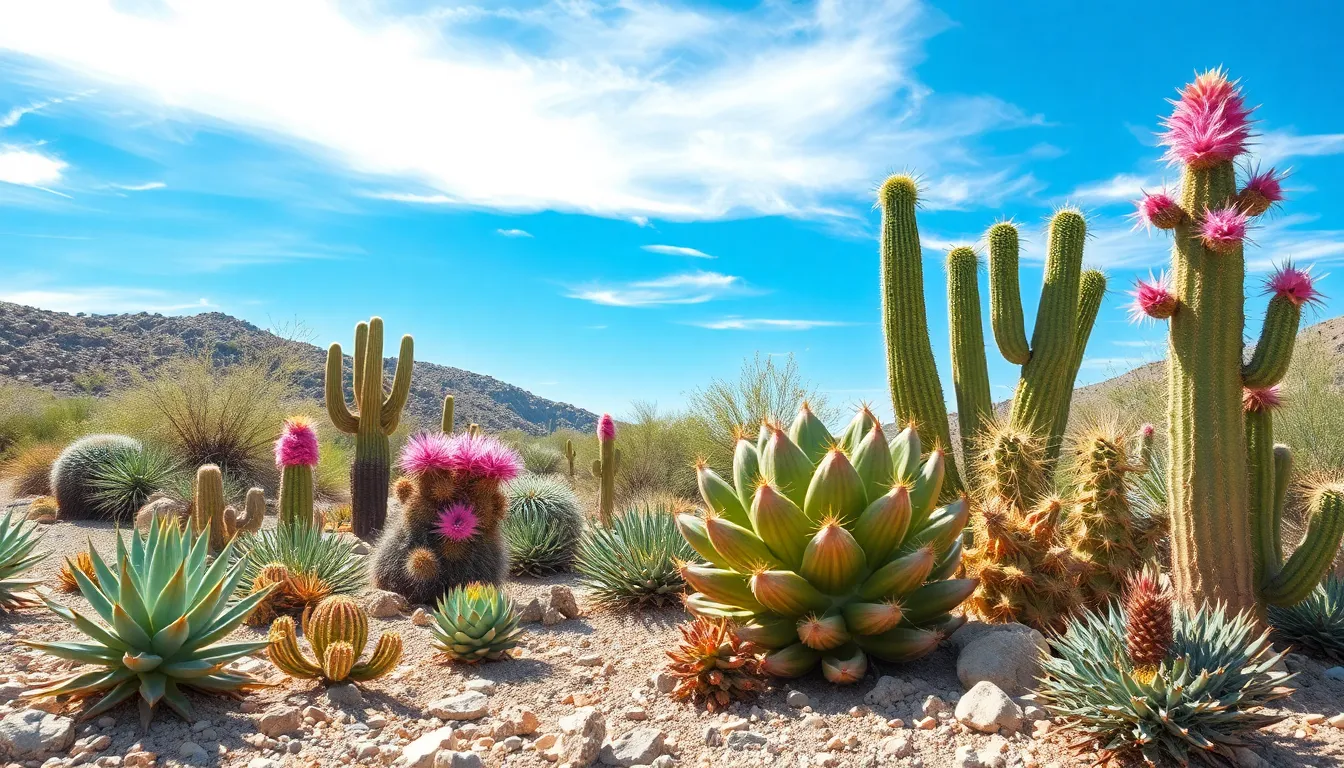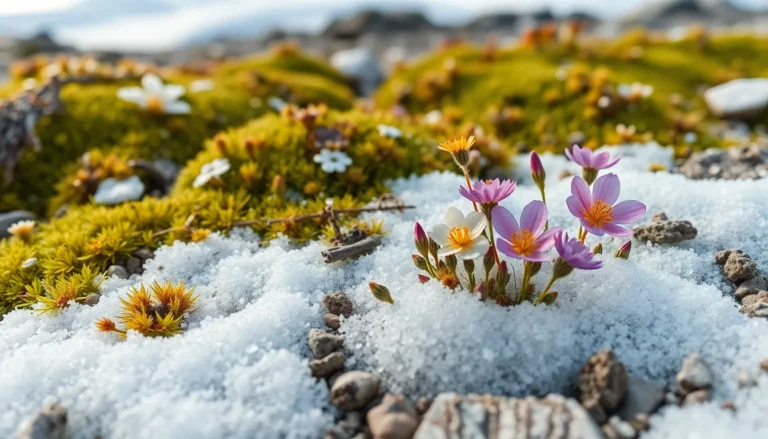
Plants That Grow in the Desert: Discover Nature’s Resilient Survivors
Deserts might seem like barren wastelands, but they’re actually bustling with life—just in a very dry and prickly way. Imagine a place where plants have mastered the art of survival, sporting spines instead of leaves and sipping water like it’s a fine wine. These resilient green warriors have adapted to thrive in extreme conditions, proving that even in the harshest environments, life finds a way.
From the iconic cactus to the quirky Joshua tree, desert plants are nature’s version of the ultimate survivalists. They’ve got tricks up their sleeves—like storing water and growing deep roots—to beat the heat. So, if you think the desert’s just a hot, sandy expanse, think again. Dive into the fascinating world of desert flora, and discover how these remarkable plants not only survive but thrive in one of Earth’s toughest climates.
Overview of Desert Plants
Desert plants exhibit remarkable adaptations to survive in harsh environments. Some species, such as cacti, store water in their fleshy tissues, allowing them to thrive in prolonged droughts. Others, like the creosote bush, have developed an ability to minimize water loss through specialized leaves.
Deep root systems play a crucial role in accessing moisture from below the surface. These roots can extend several feet into the ground, tapping into underground water sources. Meanwhile, shallow roots capture rainfall quickly, ensuring access to brief periods of moisture.
The presence of thick, waxy coatings on many desert plants reduces evaporation. This adaptation helps retain moisture during extreme heat. Furthermore, some species exhibit nocturnal blooming patterns, opening flowers at night to attract pollinators while minimizing water loss.
In addition to their physical adaptations, desert plants showcase various reproductive strategies. Many produce seeds capable of lying dormant until ideal conditions arise. Rainfall triggers rapid germination, enabling the plants to take advantage of fleeting moisture.
Diversity among desert flora is significant. Joshua trees, for example, are iconic in North American deserts, while agave plants play essential roles in ecosystems across various climates. Each plant contributes to the intricate balance of its environment, supporting a variety of wildlife.
Desert plants inspire fascination due to their resilience and beauty. Understanding their adaptations provides insight into the complexity of desert ecosystems, challenging perceptions of these regions as barren landscapes. By studying them, one can appreciate the life that thrives in the harshest conditions.
Adaptations of Plants That Grow in the Desert

Desert plants exhibit remarkable adaptations that enhance their survival in extreme conditions. These adaptations ensure their resilience and efficiency in resource utilization.
Water Conservation Strategies
Succulent plants, like cacti, store water in their thick, fleshy tissues, allowing them to endure prolonged dry periods. Specialized leaves or modified structures help minimize water loss. Some plants develop small leaves or spines instead of broad foliage, further reducing transpiration. Waxy coatings on surfaces create a barrier against evaporation. Additionally, deep root systems reach moisture sources underground, while shallow roots quickly absorb rainwater. Dormant seeds can remain viable for years, germinating only when moisture is sufficient.
Temperature Regulation Mechanisms
Insulation features, such as thick outer layers, protect against extreme heat. Some plants open their stomata at night, reducing water loss while allowing gas exchange. Leaf orientation varies to minimize direct sunlight exposure during peak temperatures. Colors of leaves may reflect sunlight, helping to keep temperature lower. Specific growth patterns, including eaves that move with the sun, optimize light and heat absorption. These mechanisms collectively maintain internal temperatures within a range suitable for growth.
Types of Plants That Grow in the Desert
Desert ecosystems host a variety of resilient plants that have adapted to survive extreme conditions. These plants display unique characteristics that allow them to flourish in such environments.
Cacti
Cacti represent a notable group of desert plants known for their ability to store water. Their thick, fleshy stems act as reservoirs, enabling them to withstand long periods of drought. Spines replace leaves, minimizing water loss and providing protection from herbivores. Many cacti, such as the saguaro, thrive in the Sonoran Desert and can grow tall, providing habitat for various wildlife. Nighttime respiration helps cacti conserve water while engaging in essential gas exchange.
Succulents
Succulents embrace water-storing capabilities, with fleshy leaves that retain moisture. Examples include aloe vera and agave, plants that have adapted to survive harsh conditions. Thick, waxy cuticles cover their surfaces, reducing evaporation rates. Some succulents expand their growing seasons, taking advantage of cooler temperatures. These plants often exhibit diverse colors and shapes, adding beauty to arid landscapes. Many can flourish in sandy soils, showcasing their resilience in drought-prone areas.
Drought-Resistant Shrubs
Drought-resistant shrubs play a vital role in desert ecosystems. Species like creosote bush and ocotillo exhibit deep roots that tap into underground moisture. Some produce small leaves or even drop them during dry spells to conserve water. Adaptations such as waxy coatings and fibrous root systems enhance their survival. These shrubs provide essential shelter and food for various desert wildlife, fostering biodiversity within these seemingly barren landscapes. Uniquely, some can endure extreme temperature fluctuations, highlighting their remarkable resilience.
Importance of Desert Plants
Desert plants play a crucial role in maintaining the balance of their ecosystems. Their survival strategies enhance biodiversity while supporting wildlife.
Ecosystem Support
Plants in desert environments provide vital resources for various animal species. Cacti and shrubs offer food and shelter, creating habitats for insects, birds, and mammals. These plants stabilize soil with their root systems, reducing erosion and promoting water retention. Such stabilization benefits other plants, allowing them to thrive in harsh conditions. The presence of diverse plant species fosters a complex web of interactions among organisms. This connection highlights the importance of each plant in a functioning ecosystem.
Cultural Significance
Desert flora holds significant cultural value across many communities. Indigenous peoples utilize plants, such as Joshua trees and agave, for food, medicine, and crafting materials. These plants often feature prominently in traditional practices and folklore. Many communities respect desert plants for their resilience, symbolizing adaptability and survival. Awareness of their cultural importance encourages conservation efforts. Protecting these species ensures the preservation of cultural heritage linked to desert ecosystems.
Conclusion
Desert plants embody resilience and adaptability in some of the harshest environments on Earth. Their unique survival strategies not only ensure their own existence but also contribute significantly to the ecosystem’s health. By supporting diverse wildlife and stabilizing soil, these plants play a crucial role in maintaining the delicate balance of desert habitats.
Moreover, the cultural significance of these plants highlights their importance beyond ecology. They serve as vital resources for indigenous communities, reminding us of the deep connections between people and nature. Recognizing the beauty and complexity of desert flora encourages a greater appreciation for these remarkable ecosystems. Embracing this knowledge fosters a commitment to conservation efforts, ensuring that future generations can also marvel at the wonders of desert life.



